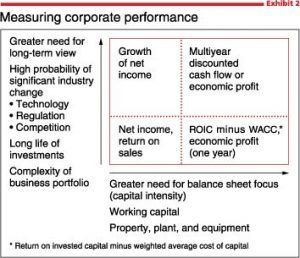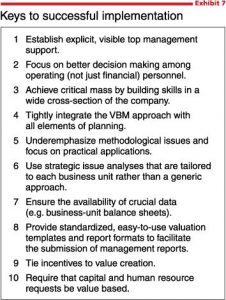Value-Based Management

How can we perform better? That’s the question the plagues just about any manager across all organizations. While it is possible to integrate the latest managerial techniques, even the most promising can end up failing. Why is that? According to McKinsey,“[o]ften the cause of failure was performance targets that were unclear or not properly aligned with the ultimate goal of creating value.” Value is going to be at the heart of what you’ll tackle during Financial Decision Making for Managers, so if that is going to be in the back of your mind, why not approach your organization and how you manage it with value at the forefront?
What’s value-based management?
Value-based management, also known as VBM, seeks to rectify the disconnect between performance targets and value creation. McKinsey reports that “[i]t provides a precise and unambiguous metric—value—upon which an entire organization can be built.” Indeed, this management technique aims “…to ensure corporations are run consistently on value (normally: maximizing shareholder value).” We can also understand that value-based management, along with creating economic value, includes managing for value as well as valuation and that the intricacies of the organization are structured to maximize shareholder value. The way a company gets there, naturally, depends on its purpose, and of course, its values. In the case of Financial Decision Making for Managers, the corporate purpose is economically based on its emphasis on maximizing shareholder value, but some companies’ purpose can also strive to maximize stakeholder value.
How does it work?
How do we know how much a company is worth, or better said, its value? We can tell based on its discounted future cash flows: “[v]alue is created only when companies invest capital at returns that exceed the cost of that capital.” Mainly, it’s the same logic behind our checking accounts: we can only spend the money that we have. If we make more money, we have more cash to spend.
But VBM goes beyond that simple concept
In VBM, the logic is to analyze how enterprises use discounted future cash flows “…to make both major strategic and everyday operating decisions.”
What happens when it’s done well?
According to McKinsey, “[p]roperly executed, it is an approach to management that aligns a company’s overall aspirations, analytical techniques, and management processes to focus management decision making on the key drivers of value.” The first component of the effective use of VBM is to recognize that top-down management is not going to work. Instead, managers should employ “…value-based performance metrics for making better decisions.”
How does this work? It involves managing two tasks. First, the balance sheet and the income statement must be appropriately handled. And, along with that, it also requires that you equally consider short-term and long-term perspectives. Still not convinced? McKinsey explains “…[i]t is like restructuring to achieve maximum value on a continuing basis. It works. It has high impact, often realized in improved economic performance.”
What you need for VBM to work
Value-based management, McKinsey warns, should not merely be a method for improving business performance. Managers that decide to implement VBM also need to continually ask themselves why they are looking to grow the business. First, you’ll need the proper financial metrics. If you thought that the traditional ones such as earnings or earnings growth are the right ones to track, think again. The most direct form of value creation is discounted cash flow value, so you should stick with this metric on the financial side.
Maximizing value is the ultimate financial goal, but corporations naturally have non-financial goals. Will those goals sometimes be more important than maximizing value at any cost? Quite possibly yes; that’s why management needs to have them to boost morale, but of course, they should be in line with the company’s financial health. Those corporations successful at completing nonfinancial objectives, contrary to what you may think, are some of the most prosperous.
Then, of course, you need to decide the adequate objectives for every level of your organization. That will require each department to analyze where the value-drivers are carefully, and choose an appropriate KPIs to get there.
Need convincing of the discounted cash flow’s value as a KPI?

Source: McKinsey
The adequate metric, for both considering the need of management of the balance sheet and taking the long-view on the life of the corporation, is in fact, the discounted cash flow, according to this chart.
In sum, we leave you with the keys that McKinsey gives us for successfully putting value-based management into effect:

Source: McKinsey
Throughout the Financial Decision Making in Everyday Financial Decision Making program, you’ll get many of the financial tools you need to put value-based management into practice for value-driven decision-making.
How can I join in on the action?
If you’re eager to learn more about this HiOP, click here to download your copy of our informational brochure. If you’re already set to embed financial knowledge with us, go ahead and get started on your application right now.



